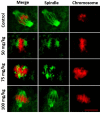Follicle Rescue From Prepubertal Ovaries After Recent Treatment With Cyclophosphamide-An Experimental Culture System Using Mice to Achieve Mature Oocytes for Fertility Preservation
- PMID: 34631518
- PMCID: PMC8497963
- DOI: 10.3389/fonc.2021.682470
Follicle Rescue From Prepubertal Ovaries After Recent Treatment With Cyclophosphamide-An Experimental Culture System Using Mice to Achieve Mature Oocytes for Fertility Preservation
Abstract
Ovarian tissue cryopreservation is the only feasible method for fertility preservation in prepubertal girls that will undergo gonadotoxic chemotherapy. To date, the only clinical use of cryopreserved tissue is by a later tissue retransplantation to the patient. Clinical challenges in fertility preservation of very young patients with cancer include time constraints that do not allow to retrieve the tissue for cryopreservation before starting chemotherapy and the preclusion of future ovarian tissue transplantation due to the risk of reintroduction of malignant cells in patients with systemic diseases. To overcome these two challenges, we investigated using an experimental model the feasibility of retrieving secondary follicles from ovaries of prepubertal mice after cyclophosphamide (CPA) treatment in increasing doses of 50, 75, and 100 mg/kg. The follicles were thereafter cultured and matured in vitro. The main outcomes included the efficiency of the method in terms of obtained matured oocytes and the safety of these potentially fertility preservative procedures in terms of analyses of oocyte competence regarding normality of the spindle and chromosome configurations. Our findings demonstrated that it was feasible to isolate and culture secondary follicles and to obtain mature oocytes from prepubertal mice ovaries recently treated with CPA. The efficiency of this method was highly demonstrated in the 100 mg/kg CPA group, with near 90% follicle survival rate after 12 days' culture, similarly to control. Around 80% of the follicles met the criteria to put into maturation, and more than 40% of them achieved metaphase II, with normal spindle and chromosome configurations observed. Suboptimal results were obtained in the 50 and 75 mg/kg CPA groups. These paradoxical findings towards CPA dose might probably reflect a more difficult selection of damaged growing follicles from ovaries recently treated with lower doses of CPA and a hampered ability to identify and discard those with reduced viability for the culture.
Keywords: chemotherapy; cyclophosphamide; female fertility preservation; in vitro culture and maturation; ovarian follicle isolation; prepubertal ovary.
Copyright © 2021 Hao, Anastácio, Viñals-Ribé, Santamaria Lacuesta, Diakaki, Alonso de Mena, Liu and Rodriguez-Wallberg.
Conflict of interest statement
The authors declare that the research was conducted in the absence of any commercial or financial relationships that could be construed as a potential conflict of interest.
Figures



Similar articles
-
Cryopreservation of in vitro matured oocytes in addition to ovarian tissue freezing for fertility preservation in paediatric female cancer patients before and after cancer therapy.Hum Reprod. 2016 Apr;31(4):750-62. doi: 10.1093/humrep/dew007. Epub 2016 Feb 4. Hum Reprod. 2016. PMID: 26848188
-
Feasibility of Secondary Follicle Isolation, Culture and Achievement of In-Vitro Oocyte Maturation from Superovulated Ovaries: An Experimental Proof-of-Concept Study Using Mice.J Clin Med. 2021 Jun 23;10(13):2757. doi: 10.3390/jcm10132757. J Clin Med. 2021. PMID: 34201725 Free PMC article.
-
Advancing fertility preservation in prepubertal mice: Efficacy of ovarian tissue culture and in vitro growth in mature oocyte development.J Obstet Gynaecol Res. 2024 Sep;50(9):1713-1721. doi: 10.1111/jog.16057. Epub 2024 Aug 18. J Obstet Gynaecol Res. 2024. PMID: 39155407
-
[Fertility preservation in prepubertal children].Bull Cancer. 2011 May;98(5):489-99. doi: 10.1684/bdc.2011.1362. Bull Cancer. 2011. PMID: 21609893 Review. French.
-
Is the pre-antral ovarian follicle the 'holy grail'for female fertility preservation?Anim Reprod Sci. 2019 Aug;207:119-130. doi: 10.1016/j.anireprosci.2019.05.017. Epub 2019 Jun 1. Anim Reprod Sci. 2019. PMID: 31208845 Review.
References
-
- Rodriguez-Wallberg KA, Marklund A, Lundberg F, Wikander I, Milenkovic M, Anastacio A, et al. . A Prospective Study of Women and Girls Undergoing Fertility Preservation Due to Oncologic and non-Oncologic Indications in Sweden-Trends in Patients’ Choices and Benefit of the Chosen Methods After Long-Term Follow Up. Acta Obstet Gynecol Scand (2019) 98(5):604–15. doi: 10.1111/aogs.13559 - DOI - PubMed
LinkOut - more resources
Full Text Sources
Miscellaneous

